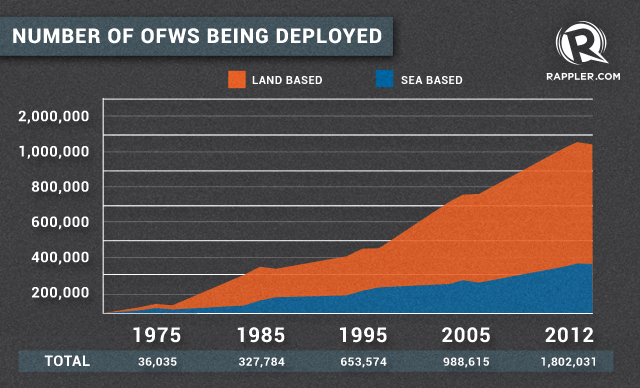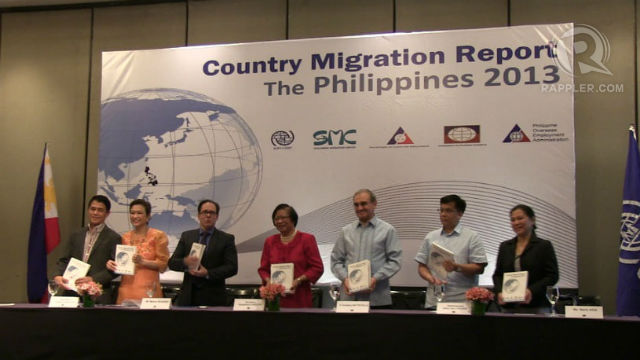SUMMARY
This is AI generated summarization, which may have errors. For context, always refer to the full article.

MANILA, Philippines – The number of overseas Filipino workers (OFW) being deployed to other countries has been constantly increasing for the past 3 decades.
This was according to the Country Migration Report (CMR) of the International Organization for Migration (IOM), an intergovernmental organization that assesses migration movements for informed policy making.
According to the report, the first recorded statistics on overseas employment started in 1975, a year after the Labor Code of the Philippines was passed. In that year, 36,035 Filipinos left the country to work abroad.
A decade later in 1985, the numbers were already at 372,784 — more than 10 times the 1975 figures. In 2012, the Philippines deployed a total of 1,802,031 workers, half of whom were rehires.
Deployment data from the Philippine Overseas Employment Administration (POEA) showed that the occupational distribution has diversified throughout the years, although most OFWs still opt to become domestic workers.
The following data show the number of deployed newly-hired, land-based workers by major occupational category in 2012:
-
Service workers (Domestic workers) – 222,260
-
Production workers (factories) – 146,448
-
Professional and technical workers (Dancers, singers, nurses) – 54,617
-
Clerical workers – 13,893
-
Sales workers – 9,346
-
Administrative and managerial – 3,241
-
Agricultural workers – 1,563
Middle East-bound
The study also showed that the Middle Eastern countries remain the primary destinations for over 67% of OFWs. The Kingdom of Saudi Arabia remained as the top destination for many workers.
Data revealed that 70% of OFWs go to the top 5 destination countries. The percentage of OFWs in the 5 countries in 2012 are as follows:
-
Saudi Arabia – 24.4%
-
United Arab Emirates – 18.8%
-
Singapore – 10.2%
-
Hong Kong, China – 7.9%
-
Qatar – 7.8%
The report also showed that the number of seafarers increased by 75% in the past 10 years. Filipinos constitute 20-25% of all international seafaring crews. This backs the Philippine claim of being the ship-manning capital of the world.
Filipinos abandoning ship?
The Philippines was recorded among the top countries of origin in the traditional immigration countries. Permanent emigration from the Philippines has also increased in the past 3 decades.
More than 1.8 million Filipinos emigrated to settle in other countries from 1981 to 2011. The United States topped the list of destination countries with 64.84% or 1,203,815 Filipinos.
The report also said the rate of permanent return is slow due to the limited wage-competitive opportunities in the country.
Department of Labor and Employment (DOLE) secretary Rosalinda Baldoz, however, said that a lot of OFWs are already planning to return to the Philippines because of the positive growth in the economy.
“When I was in Italy…we gave a seminar on agri-business…A lot of the Filipinos there are already planning to return to the Philippines and start their own business here,” Baldoz noted.

Commission on Filipino Overseas (CFO) secretary Imelda Nicolas also maintained that the Aqunio government’s main priority is to generate domestic jobs.
“Remove the impression that the Philippine government is promoting migration…we are creating jobs here in the country so they (OFWs) can return,” she said.
Nicolas noted that although the demand for jobs abroad will always exist, the government’s goal is to lessen the number of Filipinos leaving the country.
“As the president always said, we want migration to be a matter of choice and not a necessity,” Nicolas added.
‘Migration bible’

A first for the Philippines, the CMR gives a comprehensive and integrated migration management profile of the country. It assessed the extent, impact and governance of migration in the Philippines along with the different policies and institutions involved.
The report, which was based on inclusive consultation and data-mapping, took two years to complete.
POEA Administrator Hans Leo Cacdac said that the report will give the government a broader perspective.
“It will enhance coordination because if we know more about the complete migration picture that is being…undertaken by various government agencies…then the more we will be conscious of the fact that we need to coordinate, cooperate and reach out…,” Cacdac added.
DOLE, POEA and CFO were among the 30 contributing institutions and organizations in the study. -Rappler.com
Add a comment
How does this make you feel?
There are no comments yet. Add your comment to start the conversation.